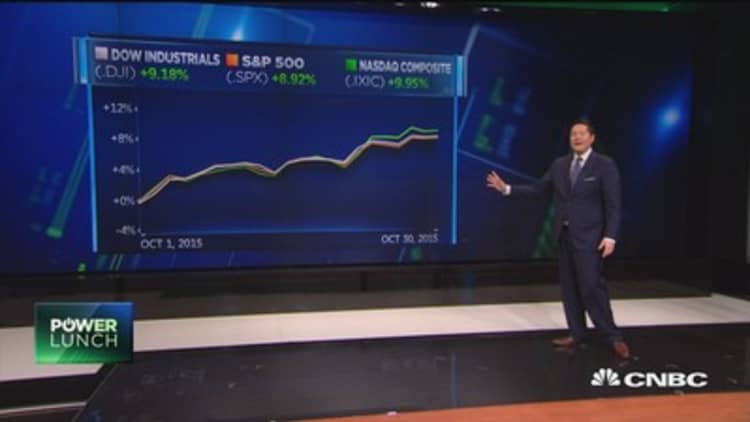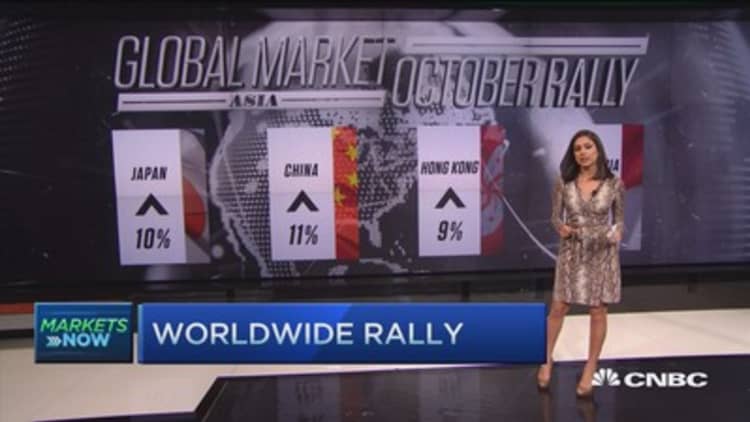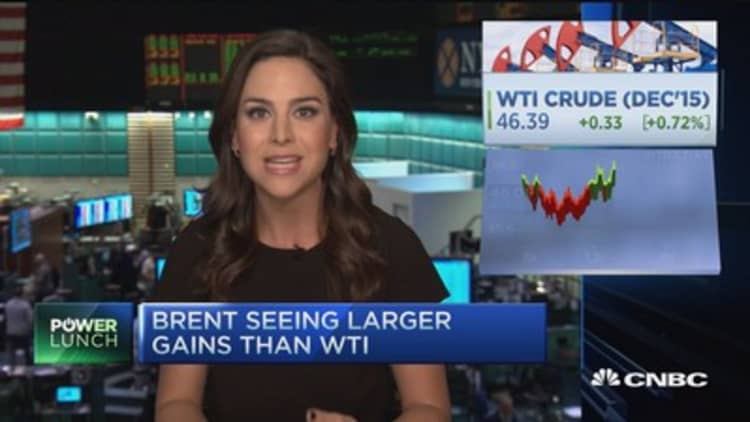



U.S. stocks ended lower Friday but closed out their best month in four years, helped by a recovery in oil prices and hopes of easy monetary policy. (Tweet This)
Stocks extended losses into the close, after struggling to hold opening gains. The Dow Jones industrial average ended about 90 points lower, with Goldman Sachs weighing the most on the index.
"We continue to see selling pressure in stocks and buying pressure in bonds as people put money there ahead of the weekend," JJ Kinahan, chief strategist at TD Ameritrade, said of morning trade. He also noted some positioning ahead of next Friday's employment report, one of two key jobs reports due before the Federal Reserve's December meeting.
Energy closed about 0.7 percent higher, giving up earlier gains of more than 1 percent. The sector led advancers in the S&P 500, while financials lagged. Crude oil settled up 53 cents, or 1.15 percent, at $46.59 a barrel.
"There's just a whole lot of uncertainty in markets right now," said Chris Gaffney, president of world markets at EverBank.
We've had "a very good month following a very poor quarter in the third quarter. I think it's some volatility and questioning."
Read MoreSo just how great was October for markets?
The major averages had their best month since October 2011. The S&P 500 closed up 8.3 percent for the month, while the Dow ended nearly 8.5 percent higher for the month. The Nasdaq composite finished October up nearly 9.4 percent.
"You still have very stimulative measures," said Nick Raich, CEO of The Earnings Scout. "You have people who performance chase into the end of the month. It's been a phenomenal October."
He said of the 68 percent of S&P 500 firms that have reported so far, 72 percent have beat earnings estimates but only 43 percent have beat revenue forecasts. That percentage of sales beats is below the 58 percent average, Raich said.
Read MoreStocks could fade after best month in four years
Soft economic data in October encouraged investors' hopes of a delayed U.S. rate hike, while talk of further stimulus from the European Central Bank and a rate cut in China added to a global trend of easy monetary policy.
"Absent central bank intervention, this October rally would have fizzled," Raich said.
Some recovery in oil prices and diminished concerns about negative impact from China slowdown also supported October's gains. The S&P 500 and Nasdaq composite ended the month with gains for the year so far, and the Dow within 1 percent of breaking even for 2015.
"We're now seeing China may be a soft landing, not a hard fall," Gaffney said.
WTI crude closed up 3.33 percent for the month, after hitting its highest level since July of $50.92 a barrel in October.
European stocks ended mixed Friday, under some pressure from weak corporate earnings, but the DAX, CAC and Euro STOXX 600 posted their best month in 6 years.
Japan's Nikkei closed nearly 0.8 percent higher after the Bank of Japan kept monetary policy steady. The index gained 9.75 percent in October for its best month since April 2013.
The Shanghai composite and Hang Seng both ended lower on the day but posted their best month since April this year. The Shanghai composite had its first positive month in five.
Read MoreJanet Yellen just got some pretty bad news
In U.S. economic news, personal income rose 0.1 percent in September, while personal consumption rose 0.1 percent.
The employment cost index rose 0.6 percent in the third quarter.
The Fed's preferred inflation measure, the personal consumption expenditures (PCE) price index, slipped 0.1 percent in September. The decline marked the first drop since January.
PCE "certainly wasn't in the category that gives the Fed confidence that we're really pushing the needle towards strong inflation," said Quincy Krosby, market strategist at Prudential Financial.
Read MoreTepper: THIS could be 'magic formula' for stocks
After the market open, the final read for October consumer sentiment came in at 90.0.
"I don't think there's anything in today's data that moves the needle," said Peter Boockvar, chief market analyst at The Lindsey Group.
He noted that outside the gains in the major U.S. averages for the week and the month, the Shanghai Composite ended nearly 1 percent lower for the week, despite last Friday's rate cut by the People's Bank of China.
In the United States, the Russell 2000 and Dow transports also underperformed the major averages for the week and month.
U.S. stocks closed slightly lower Thursday, holding most of Wednesday's rally after the Federal Reserve statement gave investors more confidence in the possibility of a December rate hike.
"The SPX has retained positive short-term momentum this week despite prolonged short-term overbought conditions," BTIG Chief Technical Strategist Katie Stockton said in a note. "We attribute the resiliency of the market to positive fourth-quarter seasonality combined with a bullish reaction to earnings. A pullback has unfolded in emerging markets that may negatively affect sentiment in the U.S. in the days ahead, but we would view resulting weakness as an opportunity to add exposure."
Treasury yields remained near recent highs, with the 10-year yield at 2.14 percent and the 2-year yield at 0.74 percent around the close.
The U.S. dollar traded about half a percent lower against major world currencies, with the euro near $1.10 and the yen at 120.66 yen against the dollar.
Gold futures settled down $5.90 at $1,141.40 an ounce.
Read MoreFed's Lacker: Here's why I dissented at last FOMC vote
Kansas City Fed President Esther George said Friday in a Reuters report that the U.S. economy will likely expand this year at a pace consistent with its longer-term trend rate and the labor market has healed "fairly rapidly."
Separately, San Francisco Fed's John Williams said during a panel discussion at the Brookings Institute in Washington that low interest rates are a warning sign of possible changes in the U.S. economy that the central bank does not fully understand.
Major U.S. Indexes
On the earnings front, AbbVie, Colgate-Palmolive and Exxon Mobil all reported before the bell.
Read More Early movers: VRX, NWL, FNFG, CL, ABBV, CVS, ITT, BUD, MYL & more
Exxon Mobil reported quarterly results that beat on both the top and bottom line, but profit declined 47 percent as low oil prices weighed.
Chevron announced plans to cut its workforce by 6,000 to 7,000, while posting earnings that topped expectations.
Markets also kept an eye on news the United States will send a small number of special operations forces to Syria.
"I don't think that's going to have an effect today, but once you start putting forces anywhere the potential for conflict increases," Kinahan said.
The Dow Jones industrial average closed down 92.26 points, or 0.52 percent, at 17,663.54, with Pfizer the greatest decliner and Caterpillar leading advancers. DuPont was the best gainer on the month, while Wal-Mart was the worst performer.
The closed down 10.05 points, or 0.48 percent, at 2,079.36, with energy leading five sectors higher and financials the greatest laggard. All 10 sectors closed higher for the month, with materials the greatest gainer.
The Nasdaq closed down 20.53 points, or 0.40 percent, at 5,053.75.
The CBOE Volatility Index (VIX), widely considered the best gauge of fear in the market, held near 15.
About seven stocks declined for every eight advancers on the New York Stock Exchange, with an exchange volume of 1.1 billion and a composite volume of 4.2 billion in the close.
High-frequency trading accounted for 49 percent of October's daily trading volume of about 7.1 billion shares, according to TABB Group. During the peak levels of high-frequency trading in 2009, about 61 percent of 9.8 billion of average daily shares traded were executed by high-frequency traders.
—Reuters contributed to this report






